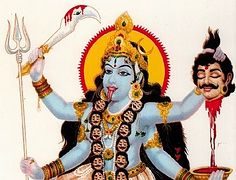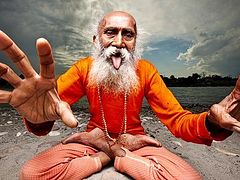Walking along the streets of Moscow, St. Petersburg, Volgograd, Kaluga or any other large city will be enough to get added evidence that today yoga is a popular and widespread phenomenon. Yoga advertising posters, if not signboards of yoga centers, will inevitably catch your eye. Or you can get on the internet instead of going outside. For instance, the Yandex Russian top search engine has as many as 850 million search results for the query “yoga” compared to only 474 million results for the query “Orthodoxy” (that is, half as many results).
As we know, the Soviet Union collapsed, and its godless ideology wasn’t replaced with a new one. On the contrary, the state declared that it wouldn’t support any ideology thenceforth. But that’s not how life works. For the absence of ideology is a kind of an ideology in itself and it has contributed to the unprecedented propagation of the ideas that had been banned and oppressed by the atheist state for decades. The Church came out from the underground too. However, the minds and hearts of the overwhelming majority of the former Soviet citizens were captivated by other phenomena and teachings the representatives of which emerged, made themselves known, and immediately began to “preach” on TV, the internet, in the press and other mass media. These were psychics, sorcerers, astrologers, fortune-tellers, adherents of alternative medicine, and, of course, yogis…
What are the similarities between yoga and materialism?
What attracts people to yoga? In my case, it was a thirst for something mysterious, some teaching that would allow me to develop some superpowers, such as telepathy, breath-holding, etc. I discovered yoga as a primary school student back in the early 1980s thanks to my elder cousin. I would sit in the lotus position at the lessons, and the teacher would rebuke me, telling me “to sit like a human”. And my last mentor was a yoga fitness instructor, under whose guidance between 2008 and 2009 I refreshed my skills in the fundamentals of Ashtanga yoga that I had largely forgotten over the years of my office work. And there were a great number of books, groups, seminars, and teachers between these two “mentors”.
When I was in my thirties, I wanted to comprehend the essence of yoga, and I was more interested in meditative practices than in physical exercises (asanas). The fact is that if someone starts yoga and doesn’t quit it, sooner or later he will find that it is boring to sit in the same positions and do the same exercises day in and day out. One day he will inevitably ask himself: “Why do I need all of this”? And this is precisely what happened to me: I wanted to find the meaning. And at last I discovered the concept of pralaya in Hinduism which (to put it simply) means “cyclical destruction of the universe”. No matter what you did (whether you practiced yoga or something else), what you strove for, how many times you were born, which class or caste you belonged to, all the souls (whether they like it or not) will ultimately unite into one “golden egg”, into which the whole universe will contract, once one “day of Brahma” has changed into a “night of Brahma” next time. It will be the end of the universe, and all will disappear. From the yogis’ point of view, there is no such thing as immortality of an individual soul because with the beginning of a “new day of Brahma” the souls will come into being again, but these will be absolutely different souls (not those destroyed). Only Brahman, the impersonal absolute, is immortal.
There are many similarities between all of this and the materialist conception of the world, the “pulsating universe theory”, and so forth. However, there are quite a few tendencies in Hinduism (of which yoga is a part), from atheistic and agnostic to pantheistic, those recognizing many deities and close to paganism.
Then what is the object pursued by a yogi? He seeks to attain the state of Moksha, or Samadhi, approximately meaning “being released”. This is the “liberation” from the cyclic existence, this suffering-laden cycle of life. A yogi believes in reincarnation, in the rebirth cycle, but he tries his best to avoid this continued suffering.
When I came to realize that, according to yoga, death awaits you in any case (both the physical death and the death of your soul, once it has escaped the vicious birth-death-rebirth cycle and united with the indifferent absolute), I lost interest in this teaching. Later, in the summer of 2010, I ended up at the Monastery of St. Paphnutius in Borovsk [in the Kaluga region south of the Moscow region] completely “by chance” (in fact, providentially), and my life was gradually transformed.
Why is yoga inescapably religious?
But why not practice yoga as we do gymnastics, without becoming absorbed in its mysterious and occult depths? I am quite sure that this is impossible (except when someone is fortunate enough in having a transient passion for yoga). Yoga is part of the Hindu religion, and there’s no getting away from it. The very word “yoga” derives from the Sanskrit root word “yuj”, meaning “to yoke”, “to unite”, “to join”. Meanwhile the word “religion” derives from the Latin verb “religare”, meaning “to tie”, “to bind together”. In both cases you connect to God or some other invisible forces that interact with you. So at very least it would be illogical to state that yoga is not religious as the words “religion” and “yoga” are almost synonyms. The problem is that people seldom take the trouble to grasp the hidden meaning of words.
Websites dedicated to yoga often contain quotations from the Gospel and portray Christ as a yogi. This “message” is addressed to the nominal, unchurched “Orthodox” who make up the vast majority in Russia. According to the statistics, between seventy and eighty percent of Russian residents call themselves Orthodox; those who take Communion at least once a year make up less than thirty per cent; and the true children of the Church, who know the Creed by heart, are fully integrated into Church life, and regularly take Communion make up less than five per cent. Of course, yogis make use of some similar element in Christian teaching and the teaching of yoga to attract these “liberal faithful” who consider themselves Christians and may sincerely want to be followers of Christ, wear crosses on their necks, but know virtually nothing about Christ and His Church.
The question of the key difference between Orthodoxy and yoga really concerned me after my visit to the Monastery of St. Paphnutius in Borovsk. I kept asking the spiritual fathers there: “May I practice yoga? Why is it a bad idea?” While they answered the first question with confidence, they skirted the second one. So I wanted to find out the truth for myself. It eventually became the subject of my seminary thesis and even developed into the book, An Orthodox Perspective on Yoga, which was published by the Simvolik publishing house not long ago.
On superpowers and humility
On the face of it, yoga’s ethical principles are very similar to the commandments of the Bible. Thus, the principle of Ahimsa (“not to injure”, “nonviolence”) seems to be equivalent to the commandment, “Thou shalt not kill”. Brahmacharya (“continence”) is consonant with the commandment, “Thou shalt not commit adultery”. Asteya (“non-stealing”) is in harmony with the commandment, “Thou shalt not steal”. But this is what the Holy Hierarch Gregory Palamas said about similarities like these: “A lie that is not far from the truth gives rise to a double delusion. Since a tiny difference escapes the majority’s notice, they either take the lie for the truth or, on account of its closeness to the lie, take the truth for the lie, in both cases completely falling away from the truth.” These words are true about Christianity and yoga: The difference becomes manifest when you make it as simple and clear as you can.
Yoga has no principle of humility at all, though this fact is often overlooked. Yogis will argue with this statement, but the collections of Yoga Sutras, the main sources of yoga, don’t say a single word about humility, whereas in Christianity the commandment of humility is the greatest one. Blessed are the poor in spirit (Mt. 5:3) – the Savior’s Sermon on the Mount begins with these words. No virtue has any value without humility.
From personal communication with adherents of yoga whom I held in respect I was convinced that the absence of pride is fine for yogis, but they won’t need it until they reach the “spiritual heights”. While they are on their way “to the top”, they need to be motivated by pride (among other things) to speed up their progress. Thus ego becomes an “engine of progress”. Although humility is essential, they will first “achieve holiness” and then get rid of their pride. But will they succeed?
That is why Christians start with humility, relying on the will of God and not their own will.
However, someone can argue and say that while pride moves you to pursue new goals over and over again, traditional yogis aim to reach nothingness—a goal that seemingly has nothing to do with pride. It should be stressed that classical yoga no longer exists—one won’t find it, not only in Europe, but also in India, the motherland of this teaching. I concede that there may be two or three gurus in the Himalayas preaching “true yoga”, though that is very unlikely. As a matter of fact, yoga is a motley collection of various schools and tendencies. Some of them do understand that gaining supernatural powers feeds your pride and hinders your spiritual growth. Then the question arises: when do the Yoga Sutras devote so much attention (a special section) to these supernatural abilities?
And not only “Yoga Sutras”
Back in the 1960s, the documentary, “Indian Yogis, Who Are They?” was released in the USSR. Its authors presented yoga as a philosophy, a moral teaching, and health and fitness gymnastics. This film contributed to the popularization of yoga in the Soviet society, as did some publications in Soviet popular science magazines, The Razor’s Edge science fiction novel by the Soviet writer Ivan Yefremov (1907-1972), along with a number of other arts and cultural events in the Soviet Union. And what is interesting is that the modern sequel of that film, “Indian Yogis, Who Are They? Forty Years Later”, tells the viewers plainly that yoga “is a tool for awakening of your energy potential and obtaining supernormal powers”. Formerly this side of yoga was not emphasized, but it is obvious that today this way of advertising yoga works.
Man wants to become like God. It is a matter of the path he chooses. If Adam had obeyed the commandment of God, he would have remained immortal and with time could have become like God, cultivating and caring for the Garden of Eden with which God had entrusted him and growing in love. But Adam preferred the easy path, namely “to become like gods”, by eating the fruit of the tree of the knowledge of good and evil. It was “magic”, something that was not blessed by God and “outside” God. Many people see yoga precisely as entering the spiritual world “from the backdoor”. They think: “In Christianity I am obliged to obey the moral commandments, keep the fasts, go to church and so on. But why? I would rather go to a yoga center, perform asanas and pranayamas, and will get what I need!”
Nevertheless, I do hope that one way or another the Lord will bring the yogis who sincerely seek Him to His Church, the only ark of salvation. I believe that even committed adherents of yoga have simply strayed from the right path while searching for the true God. I have a feeling that many of them may become devout members of the Holy Church. After all, they are seekers of God and are not lukewarm (cf. Rev. 3:15-16).
The main area of divergence between Christianity and yoga is dogmas. What is a dogma for the majority? It is something the Church calls on them to believe in, while giving no proof of it. But yogis have their own dogmas, something they unconditionally believe in, too. And their basic tenets are very different from Christian ones.
Christians believe in a personal God
Though it is hard to perceive it, Christians confess the faith in the God Who is one in essence and three in personhood: the Father, the Son, and the Holy Spirit—the Consubstantial and Undivided Trinity. He is the Triune, One, Personal God. It is extremely difficult for Christians to comprehend the mystery of the Trinity, to say nothing of yogis and Hindus, for many of whom the Supreme Being cannot be personal. Hindus recognize the existence of rational spiritual beings and even refer to some of them as to “gods”, yet they see the absolute, Brahman, as impersonal.
Christians act on the premise that there is only one life
The concept of reincarnation that is prevalent among yogis contradicts all the Christological dogmas and is in opposition to the Christian doctrine that life is given to us only once, and it will be followed by death, resurrection, and judgment (cf. Heb. 9:27).
The Holy Church has never raised this very important idea to a dogma because there has never been a slightest doubt about this in the minds of Christians. The first argument that proponents of reincarnation usually put forward is that the belief in metempsychosis is widely spread and its origins allegedly date back to ancient times. They contend that “Christianity appeared only 2,000 years ago, whereas people had believed in transmigration of the soul for thousands of years before Christ was born.”
However, insofar as we can judge from surviving monuments, neither (traditional) ancient Greeks nor ancient Romans believed in reincarnation. We can trace back their beliefs concerning afterlife from their mythology, the earliest monuments of which go back to the time of Homer and Hesiod [c. 750 B.C.]. According to them, after death people descend to the underground kingdom—a dark place known as Hades, Erebus, and Tartarus in different traditions—where they drag out a “shadowy”, joyless, miserable existence. In fact the idea of metempsychosis didn’t appear until the time of Pythagoras and Plato (that is, the sixth to fourth centuries B.C.) and it was adopted only by some representatives of a number of schools of philosophy.
Ancient Egyptians mummified the corpses of dead people, hoping that in the future their souls would be reunited to their bodies. Ancient Hebrews believed in the resurrection of physical bodies as well, as evidenced by the famous prophecies of Ezekiel about the valley of dry bones, which will be joined together and come to life again (see Ezek. 37:1-14); the prophecy of Isaiah about the rising of dead bodies (Is. 26:19); and the prophecy in the Book of Job about the restoration of bodies from dust (Job 19:25-27). Thus, neither ancient Egyptian books nor the books of the Old Testament mention transmigration of the soul.
We can judge the Christian attitude towards incarnation by the Parable of the rich man and Lazarus: And it came to pass, that the beggar died, and was carried by the angels into Abraham's bosom: the rich man also died, and was buried; And in hell he lift up his eyes, being in torments, and seeth Abraham afar off, and Lazarus in his bosom (Lk. 16:22-23). The narrator, our Lord Jesus Christ, made it clear that after death human souls don’t transmigrate from one body to another; rather, as St. Nicholas (Velimirovich) of Serbia said, “They proceed to the abodes that they have deserved by their deeds on earth.”
Interestingly, the notion of metempsychosis didn’t exist among the ancestors of Aryan people either. At least Rig-Veda [the oldest and principal of the Vedas, composed in the second millennium B.C. and containing a collection of hymns in early Sanskrit] has no mention of rebirth.
Christians strive towards eternal life in the Heavenly Kingdom
Let us once again return to the question of the purpose of life. The ultimate goal of Hinduism is to stop suffering, while Christians aspire to everlasting and happy life with God. The idea of theosis (union with God) which is central in Orthodox Christianity is based on awareness that both God and man are persons. Given this, our union with the Creator by no means implies that we are becoming a part of His body or a cell in His organism. Rather, we can potentially contemplate God and be in communion with Him.
Yoga “without intricacies”
But someone will surely exclaim: “I don’t care about philosophy, religious systems and other intricacies! I am interested in yoga solely as a set of physical exercises and a fitness training system which give a practical result! Can I practice yoga as mere exercises?”
The point is that yoga is not limited to only physical exercises. The fact is that when you come to a yoga center, you not only begin to train your body and practice yoga poses, but you also should be prepared for “expanding your consciousness” through special exercises, breathing exercises and meditation. Yoga practice presupposes mandatory meditation.
Can we practice yoga without all this “spirituality”? Yes, we can, but it won’t be yoga in this case. There are numerous similar types of exercises directed towards increased flexibility, muscular strength, and organism’s resistance to pathogens—in a word, towards health improvement. What about Pilates, stretching, and so on? If you are interested exclusively in physical training, you’d better opt for one of these instead of falling for yoga with its “spirituality”, which smells like sulfur…









